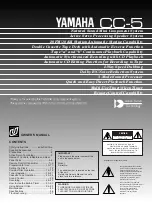
42
9.4. USING DIGITAL DELAY
This section goes beyond the typical operating guide that only explains the front and back panel
adjustments of a piece of equipment. Instead, we discuss the basic acoustical concepts needed to get
the most out of the use of digital delay in sound systems. If you are familiar with these principles, feel
free to skip ahead. Some principles may require additional delay channels and options available with
the Sabine SDA102.
Why Digital Delays?
The most intelligible sound occurs when two people speak face-to-face. The
sound is loud and dry, and the direction of the sound aligns with the speaker. The most intelligible sound
systems are the ones that come closest to emulating face to face communication. If this is your goal,
a digital delay is essential to your sound system.
There are three distinct applications for digital delays. The first and most important is
synchronization
of the loudspeakers
to control excess reverberation and echo. Second, digital delays help
control
comb filter distortion,
and finally, digital delays are useful for
aligning the acoustic image
so the
direction of the sound seems to be coming from the performer rather than from the loudspeaker.
9.4.1. Loudspeaker Synchronization
Sound travels at about 1,130 feet per second in air, or about 1 foot per millisecond. On the other hand,
electronic signals travel almost one million times faster through your sound system to the loudspeakers.
The main task for digital delays is to synchronize multiple loudspeakers so the sound traveling different
distances arrives at the listener’s ears at about the same time. Synchronizing the loudspeakers reduces
reverberation and echoes for improved intelligibility.
9.4.1.1. How to Synchronize Your Signals
There are several powerful tools available for precisely measuring the time a loudspeaker signal takes
to arrive at a certain point in the audience. Most of these tools are very sophisticated and tend to be
quite expensive. Fortunately, simpler tools are sufficient for most applications.
In the 1930s, engineers synchronized the low and high frequency speakers in movie theaters by feeding
a sharp click through the system. They moved the speakers until they could only hear a single sharp
click coming from both speakers. You can use this same method with a common child’s toy called a
clicker. Pressing the thin metal strip makes a loud sharp click. A clicker is especially useful when
synchronizing the direct sound from the performer with the sound from the loudspeakers.
Alternatively, you can use a phase checker especially for synchronizing the signals of two loudspeakers
(either LF and HF or two full range systems) since most of the phase checkers include a click generator
and receiver. Phase checkers are quite affordable and have other uses besides synchronization.
Calculating Delay Time Using Distance
Calculating delay time in terms of dis-
tance is a common and accepted
method. For a good start, estimate the
delay at 1 millisecond per foot between
speakers. Use the following equation
for more precise estimates:
These measurements presume stan-
dard temperature (68 degrees F, 20 degrees C) and pressure (29.2 in. Hg., 760 mm Hg.). Sound travels
slower in cooler or drier air and at higher pressures. For example, the speed of sound decreases about
0.61 meters per second as the temperature drops from 20 degrees C to 0 degrees C.
9.4.1.2. Processing (or Group) Delays
Converting signals back and forth from the analog to digital domain always delays the signal a little.
These conversion delays are often called processing (or group) delays, and usually range between 0.9
and 5 milliseconds. You will notice that Sabine delays always display the processing delay as the
smallest possible delay value. For the Graphi-Q, the processing delay is 1.38 milliseconds. You can
bypass the unit for 0 seconds delay.
Not all manufacturers acknowledge processing delays in their specifications, but you
must take them
into account when synchronizing your system. Make sure all digital equipment is on and not bypassed
when synchronizing. Also, be careful to make an appropriate adjustment in your delay lines if you later
add any type of digital equipment to the system.
S
ECTION
N
INE
: S
UGGESTIONS
FOR
O
PTIMAL
U
SE
OF
THE
G
RAPHI
-Q2
( )
D (distance in feet)
1130
( )
D (distance in meters)
344
Delay (milliseconds) = 1000
OR
Delay (milliseconds) = 1000















































